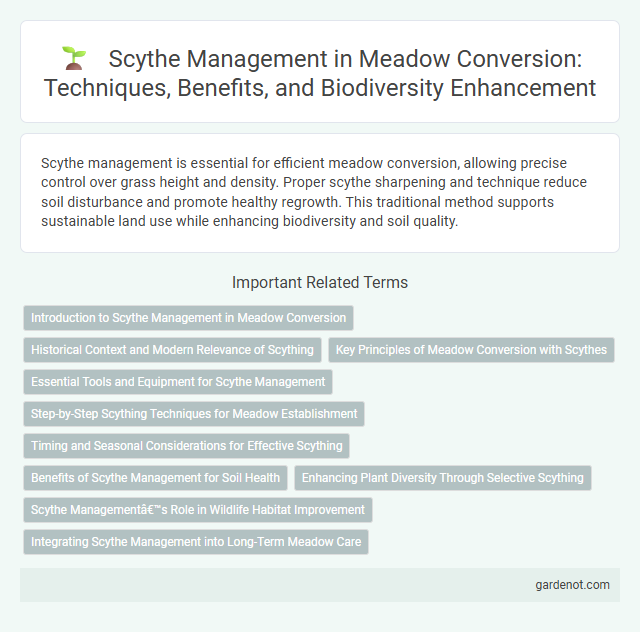Scythe management is essential for efficient meadow conversion, allowing precise control over grass height and density. Proper scythe sharpening and technique reduce soil disturbance and promote healthy regrowth. This traditional method supports sustainable land use while enhancing biodiversity and soil quality.
Introduction to Scythe Management in Meadow Conversion
Scythe management in meadow conversion involves the precise use of traditional hand tools to control vegetation and promote biodiversity. Effective scything techniques help maintain optimal grass height and composition, preventing dominance by aggressive species and encouraging wildflower growth. Proper timing and regular cutting cycles are critical to supporting habitat restoration and sustainable meadow ecosystems.
Historical Context and Modern Relevance of Scything
Scythe management traces back to ancient agrarian societies where it revolutionized cereal crop harvesting, significantly improving efficiency compared to earlier hand tools. Historically, skilled scything required expertise to maintain blade sharpness and utilize proper mowing techniques, ensuring sustainable grassland management and soil conservation. Today, scything experiences a resurgence for eco-friendly meadow conversion and biodiversity preservation, offering a low-impact alternative to mechanized mowing that supports wildlife habitats and reduces carbon emissions.
Key Principles of Meadow Conversion with Scythes
Effective meadow conversion with scythes emphasizes maintaining blade sharpness and selecting appropriate scythe length for efficient grass cutting. Proper scythe handling techniques, including correct posture and rhythmic mowing, minimize soil disturbance and promote healthy regrowth. Regular maintenance of both the blade and snath enhances cutting precision, supporting sustainable meadow management practices.
Essential Tools and Equipment for Scythe Management
Essential tools for effective scythe management include a high-quality whetstone, a curved honing stone, and a wooden peening jig to maintain blade sharpness and edge precision. Proper equipment such as a durable sharpening stone holder and a protective scythe cover ensures safety and longevity during storage and maintenance. Regular use of these tools maximizes harvesting efficiency and blade performance in meadow conversion tasks.
Step-by-Step Scything Techniques for Meadow Establishment
Step-by-step scything techniques for meadow establishment begin with adjusting the blade properly to ensure a clean cut close to the ground, encouraging healthy regrowth. Maintain a smooth, rhythmic motion with controlled swings to avoid soil disruption and promote even vegetation removal. Regularly sharpen the blade and clear debris to optimize cutting efficiency and sustain long-term meadow health.
Timing and Seasonal Considerations for Effective Scything
Optimal timing for scythe management in meadow conversion aligns with late spring to early summer when grasses reach peak growth but before seed set, ensuring nutrient-rich biomass and preventing weed establishment. Seasonal considerations include avoiding cutting during wet periods to maintain blade sharpness and prevent turf damage, while scheduling successive cuts promotes regrowth and enhances biodiversity. Managing scything intervals based on grass species phenology maximizes meadow health and supports sustainable land use practices.
Benefits of Scythe Management for Soil Health
Scythe management enhances soil health by minimizing soil compaction and preserving the natural soil structure, which promotes better aeration and water infiltration. It supports the growth of beneficial microorganisms and increases organic matter decomposition, leading to improved nutrient cycling. This method reduces reliance on heavy machinery and chemical inputs, fostering sustainable meadow ecosystems with healthier, more resilient soils.
Enhancing Plant Diversity Through Selective Scything
Selective scything in meadow management targets specific plant species, promoting a diverse habitat by preventing dominant flora from overwhelming others. This practice enhances floral variety, supporting pollinators and improving overall ecosystem resilience. Adjusting scythe timing and intensity ensures optimal growth conditions for a wide range of native meadow plants.
Scythe Management’s Role in Wildlife Habitat Improvement
Scythe management plays a crucial role in wildlife habitat improvement by promoting diverse plant growth and maintaining open meadow ecosystems. Regular scything helps control invasive species and encourages native flora, which supports a variety of pollinators, birds, and small mammals. This traditional management practice enhances biodiversity and creates favorable conditions for the survival of endangered species.
Integrating Scythe Management into Long-Term Meadow Care
Integrating scythe management into long-term meadow care enhances biodiversity by promoting diverse plant growth and preventing shrub encroachment. Efficient scythe use supports sustainable vegetation control, maintaining habitat quality for pollinators and ground-nesting birds. Regular scything cycles aligned with seasonal growth patterns optimize meadow health and ecosystem stability over time.
Scythe management Infographic

 gardenot.com
gardenot.com